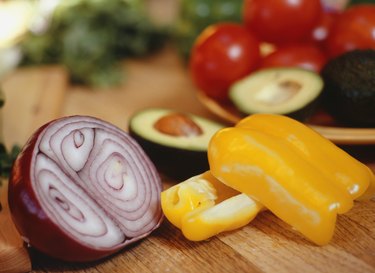
A whole foods diet doesn't require any books, complicated meal plans, calorie counting, gadgets or supplements. All you have to do is restrict your intake of processed foods and eat primarily whole foods, those that are as close to their natural state as possible. Doing this could help you lose weight, but it's especially beneficial for people with mild to severe obesity, as well as those with high blood pressure and triglycerides and glucose intolerance, according to Texas Tech University Health Sciences Center.
Why Whole Foods?
Video of the Day
Whole foods are those that have been minimally processed or are completely unprocessed when you eat them. As a result, they are free from added sugars, fats, sodium and preservatives, all of which should be limited as much as possible in a healthy diet. According to Dr. Mark Hyman, you can treat and prevent chronic illness and feel better by eating primarily whole foods rich in fiber, minerals, vitamins, phytonutrients and omega-3 fatty acids.
Video of the Day
Why It Works
Processed package and restaurant foods are notoriously high in calories from added sugar and fat. If eaten on a regular basis, these excess calories expand your waistline. By cutting processed foods out of your diet, you're limiting your intake of excessive calories, preventing weight gain and even losing weight. Just by substituting a medium plain baked potato for a medium order of fast-food french fries, you save yourself 215 calories. Over time, that can lead to considerable weight loss. Whole foods, such as whole grains, fruits and vegetables, are also high in satiating dietary fiber, which helps fill you up and keep you feeling full so you eat less.
What You Can Eat
You have a lot of options on a whole foods diet: whole grains; raw or lightly cooked fruits and vegetables; lean meats such as chicken, turkey and fish; and nuts and seeds. These foods should make up the bulk of your diet. Some whole foods diet plans eschew dairy, but in moderation low-fat dairy such as low-fat cottage cheese is acceptable, according to Texas Tech University. You can eat as much as you want of these foods to satisfy your hunger, the university notes.
What You Shouldn't Eat or Should Limit
Anything in a box, bag or package is generally off-limits. Avoid any food item with added sugars and fats. Snack foods such as crackers, frozen dinners and candy are just a few processed items you should limit or forgo. Sweetened beverages are also a no-no. Because they're processed, even whole-grain products such as whole-wheat bread and pasta are foods you should limit, Texas Tech University says. The university says this aspect is key to helping you lose weight and controlling triglycerides and blood sugar. You should also limit alcohol, starchy vegetables such as peas and potatoes, and bananas.
A Day in the Life
A sample day on a whole foods diet might look a bit like this: For breakfast, have half a grapefruit, an omelet made with two egg whites and fresh spinach and tomato, and a serving of low-fat cottage cheese. When lunch rolls around, fill a big bowl with fresh raw greens, and top them with other nonstarchy salad vegetables like cucumbers, bell peppers and sprouts. Include a source of protein such as lean chicken breast or a handful of walnuts. Sprinkle with olive oil and vinegar or lemon juice. Dinners are easy -- pair a serving of lean protein, such as salmon, with some steamed vegetables and a whole grain like brown rice. Snack on fresh fruit, nuts or cottage cheese.
- Texas Tech University: The Whole Foods Diet
- The Daniel Plan: Whole Foods for Whole People
- Harvard School of Public Health: Added Sugar in the Diet
- Colorado State University Extension: Dietary Fat and Cholesterol
- USDA National Nutrient Database: Potatoes
- USDA National Nutrient Database: McDONALD'S, French Fries